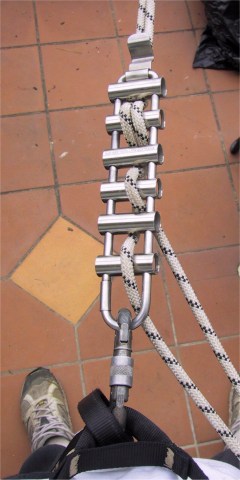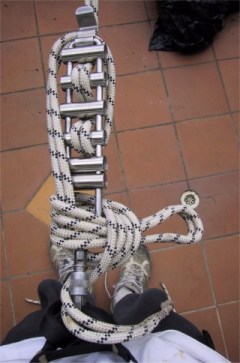
A 6 bar rappel rack, with a tie off tab at the top

One method of rigging a rack

One method of tying off a rack, using the tie off tab
The basic rack is a U or J-shaped metal frame with a number of swinging metal bars, over (and under) which the rope runs. Essentially it is like a series of mini brake bars.
The number of bars usually ranges from about 2 up to 6. The more bars, the greater the ability to control the level of friction. However, more bars means a heavier rack.
Racks have the advantage that varying levels of friction can be set fairly easily. Running the rope over more bars increases the level of friction. With J-frame racks, friction can even be added or removed during an abseil.
Friction can also be altered to a limited extent by varying the spacing between the bars.
| Safe | The main danger with racks is that if you take the weight off the device eg by stopping on a ledge, the slack can be enough to allow the bar(s) to pop up and disengage. While this is unlikely, it should be checked any time significant slack is introduced into the rope. |
| Quick release | Quick |
| In line | Yes |
| Light weight | Not generally. Some lightweight racks exist |
| Variable speed | Easy. Simply change the number of bars |
| Variable speed during descent | Some racks allow you to move the bars closer together during descent, which increases the friction. Also, some racks even allow you to add/remove bars during descent |
| Easy to lock off | Depends on the rack. For example the PFH Rap Rak (pictured) has a plate at the top for easy lock off. Others can be quite difficult. |
| Rescue use | Average to good - some racks deal well with extra weight. |
| Belay use | No |
| Heat dissipation | Good |